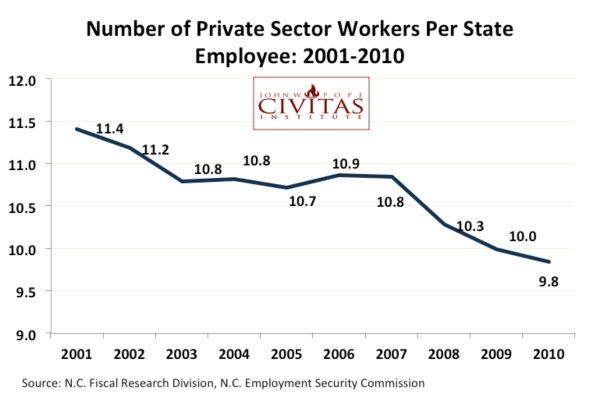Publisher's note: This informative article, by Brian Balfour, was published originally in the Economy section of Civitas's online edition.
The first decade of the 21st Century for North Carolina was a difficult one. In terms of the state’s economic condition, many may label it a lost decade.
Lost jobs, lost fiscal restraint by state government, lost opportunities for spending reform, and more lost ground in terms of worker pay. These topics all dominated North Carolina’s economic landscape during the recently-completed decade.
As we enter a crucial election season, and as the data from 2000 to 2010 becomes more complete, reviewing several of the major economic trends from this young century will add value to discussions on the future direction of the state.
We need to ask: Does North Carolina want to continue the trends established during the last decade, or stake a change in course?
Lost Jobs
The number of jobless North Carolinians nearly tripled from 2000 to 2010, adding almost 300,000 people to the ranks of the unemployed.[i] That figure is in contrast to just an 18 percent increase in the state’s working-age population. In other words, the number of unemployed North Carolinians rose at a rate ten times greater than the increase in working-age population during the last decade.
While unemployment statistics can fluctuate depending upon the number of people leaving or entering the workforce, one reliable measure of the state economy’s employment picture is the share of working-age population employed in the private sector. From 2000 to 2010, the share of working-age citizens employed by the private sector plummeted in North Carolina, dropping from 64.8 percent to 52.7 percent, a drop of nearly 20 percent in terms of the share of working-age citizens employed in the private sector.

 State Government Adds Jobs at a Healthy Clip While Private Sector Shrinks
State Government Adds Jobs at a Healthy Clip While Private Sector Shrinks
While North Carolina’s sluggish economy caused companies to shed jobs and crowd unemployment offices with out-of-work citizens, state government added more than 40,000 jobs during the last decade.
As shown below, North Carolina state legislators decided to swell state payrolls by a whopping 40,429 positions, a 14.3 percent increase. Meanwhile, private sector employment contracted by 1.3 percent, shedding 43,000 jobs.[iii]
These employment trends caused the ratio of private sector to state government worker to plummet from 11.4 in 2001 to 9.8 in 2010 – a 14 percent drop in the ratio.

 Lost Fiscal Restraint
Lost Fiscal Restraint
The last decade continued a long-term trend of out-of-control state budget growth. Even after adjusting for inflation, comparing North Carolina’s state budget to population growth for 1980-2010, we find[iv]:
State spending, even after adjusting for inflation, more than tripled from 1980-2010 State population grew by 62 percent, meaning that the state budget grew at more than three times the rate of population – even after adjusting for inflation

With the sustained expansion of the state budget outpacing population growth, the decade of the 2000’s saw the largest inflation-adjusted spending per person in a generation.[v]

• The average inflation-adjusted state spending per person for the 2000’s had risen to $2,178
• This marked an increase of 17 percent over the same average of the 1990s, and a dramatic rise of 61 percent from the 1980s average
State Debt Exploding
Despite massive spending hikes, however, state lawmakers’ appetite for spending was still not satisfied. The 2000s saw the state’s debt climb dramatically. By 2010, the state’s per capita state debt totaled more than 2.5 times the 2000 level.[vi]
Furthermore, the state’s annual payment required to pay down the growing state debt tripled.
 Losing Ground in Worker Pay
Losing Ground in Worker Pay
In addition to the substantial job losses, North Carolina lost ground to the rest of the nation and the southeast region in terms of worker pay. North Carolina’s per capita income growth during the 2000s was 25.3 percent, well below the national average of 31.7 percent. North Carolina’s income growth was even more stagnant when compared to the southeast region – which experienced per capita income growth of 33.5 percent.
This slow income growth caused North Carolina per capita income to fall even further behind the region and nation. At the beginning of the decade, North Carolina’s per capita income was 92 percent of the national average. By 2010 it had dropped to only 87.6 percent of the national average. Moreover, in 2000 North Carolina’s per capita income was above the southeast’s average, but by 2010 had fallen to just 97 percent of the region’s per capita income.[vii]

 Lost Opportunities for Spending Reform
Lost Opportunities for Spending Reform
In spite of the massive run-ups in state budgets and debt, some lawmakers made attempts at reigning in out-of-control state spending. Perhaps the most popular of such efforts is a Taxpayer Bill of Rights. TABOR is legislation that would place sensible limits on the annual growth rate of the state budget. During several legislative sessions in the 2000s, TABOR bills were introduced, but rarely received so much as placement on a committee calendar.






 • The average inflation-adjusted state spending per person for the 2000’s had risen to $2,178
• The average inflation-adjusted state spending per person for the 2000’s had risen to $2,178


